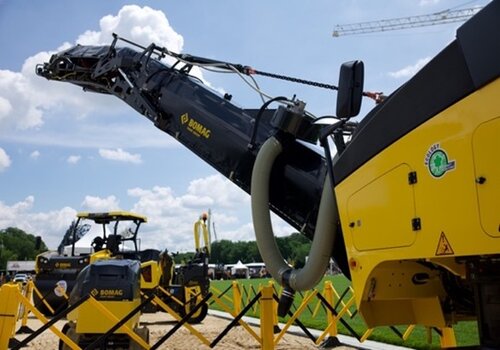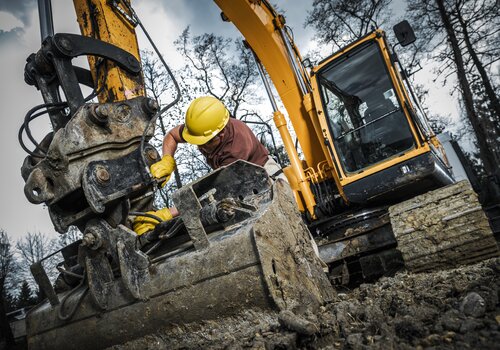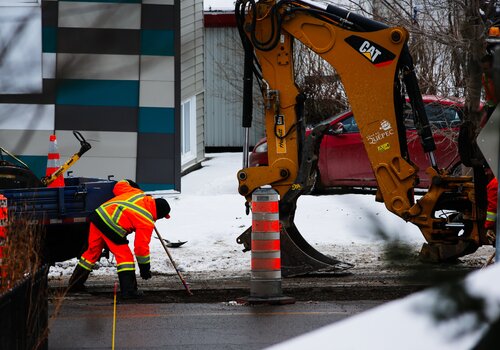Rear-discharge mixer trucks are the oldest, most popular and most iconic. Every major truck original equipment manufacturer produces a truck that can be equipped with a mixer body and can be customized for that application.
Front-discharge mixers have been around for four decades, are only found in a few regions in the US, as well as niche markets abroad, but in the regions in which they are found, they tend to dominate those markets.
Each truck has numerous options that owners can select in order to improve productivity, safety, convenience and comfort, increase machine longevity, and decrease downtime. Both types of trucks also need to meet state regulations and this helps drive the decision-making process.
Concrete Mixer Truck Options
Choices for mixer body on a rear-discharge mixer include: the manufacturer, standard or bridge model, and advanced controls option.
A bridge model is specifically designed for working on bridges; its specifications are tailored to meet weight restriction and specific state roadway laws. McNeilus manufactures a Bridgemaster model that features a patented Bridgemaster load-distribution tag axle for higher legal payloads.
McNeilus offers a new advanced control system for their mixers called FLEX controls. Two features that make these controls stand out are their diagnostic capabilities and automated features.
Other options on McNeilus mixers include several washout systems, a choice between a flip-up hopper and an SAT hopper, a ZF drum drive upgrade, and several material choices for components such as the water tank and chutes.
There is little choice when it comes to the size of the mixer; that is largely determined by the axle configuration, however, customers can choose lighter-weight chassis components and a smaller engine (nine litres instead of 13 litres) in order increase mixer capacity. If a smaller engine is chosen, the truck will not perform as well on grades and in other applications that demand higher horsepower.
Chassis Changes Come to Concrete Trucks
On the truck side, customers have a few options. Many of the options will make the truck better suited to the application. For example, a Kenworth T880S with set-forward axle is designed for customers who need to comply with federal bridge formulas.
Numerous options are available for the cab, and most of these are geared toward improving ergonomics and productivity. Popular options that may not be standard include a number of types of seats (highback, heated, leather), a rider seat option, an adjustable steering column, climate control options, other deluxe cab features, heated side mirrors, a three-panel rear window and a diagnostic system.
Trucks equipped with low-speed creeper gears allow for easier operation of the trucks when discharging concrete while moving forward slowly. This can lead to smoother, more consistent placement.
Options that are available on all both types of trucks include backup cameras, radar/LiDAR detection, and remote control.
Benefits of Front-Discharge vs. Rear-Discharge Trucks
Front-discharge trucks (and volumetric mixer trucks) come as a total package (mixer plus chassis) and both generally cost more than a rear-discharge truck.
The capital costs of the truck can be recouped since pouring can begin sooner on a front-discharge truck and this can lead to one extra delivery per day and because one laborer is eliminated with a front-discharge machine, since the chute director position is not necessary and the trucks tend to have a longer lifespan than rear-discharge ones.
Since the truck driver operates the mixer from inside the cab, some trucks have a single seat at the center of the cab. Some offer two seats for transportation of additional personnel.
How Regulations Can Impact Truck Specifications
Regulations determine some truck specifications. Local weight laws and the Federal Bridge Laws determine how much weight you can put on one axle, so where the truck will operate will determine the axle configuration.
“Once you know the weight laws, then we know which base product we need to talk about,” says Scott Kutz, Regional Sales Manager, Terex. “And, once you meet these regulations, the customer’s preference will drive the rest of the decision-making process.”
Terex’s Charger Series trucks come in three axle configurations (using either three or four axles), whereas the company’s FD Commander Series trucks come in 10 different axle configurations (using from three to seven axles).
When there are multiple axle configurations with the same number of axles, customers can choose between live front axle, or the standard axle. A live front axle provides better traction and maintains a consistent ground clearance. Both features are favored in off-road applications.
Terex offers different engine options with different horsepower and torque capacities.
“Again, you have to look at where the machine will be operating,” says Kutz. “Trucks working in urban areas where the plant is five miles away generally work on flat grades and don’t need as much horsepower as trucks working in rural areas, which are more likely to experience more grades, higher grades, and less-than-ideal driving surfaces.”
Then choose between solid suspension or air-ride suspension. The air-ride suspension offers a smoother ride and costs more.
And then you need to decorate your truck.
“We can do anything—paint, decals—if you can imagine it, we can do it,” says Kutz.
Related Reads:
- Concrete equipment: A more exact science
- Hoist, Pump, Pour - Your Best Option for Placing Concrete High Up
- Concrete and Excavation Contractor Kurk Inc.'s Longevity Comes from a Focus on People, Technology
Subscribe to the CONEXPO-CON/AGG 365 weekly newsletter to receive more great concrete and construction industry stories like this.












